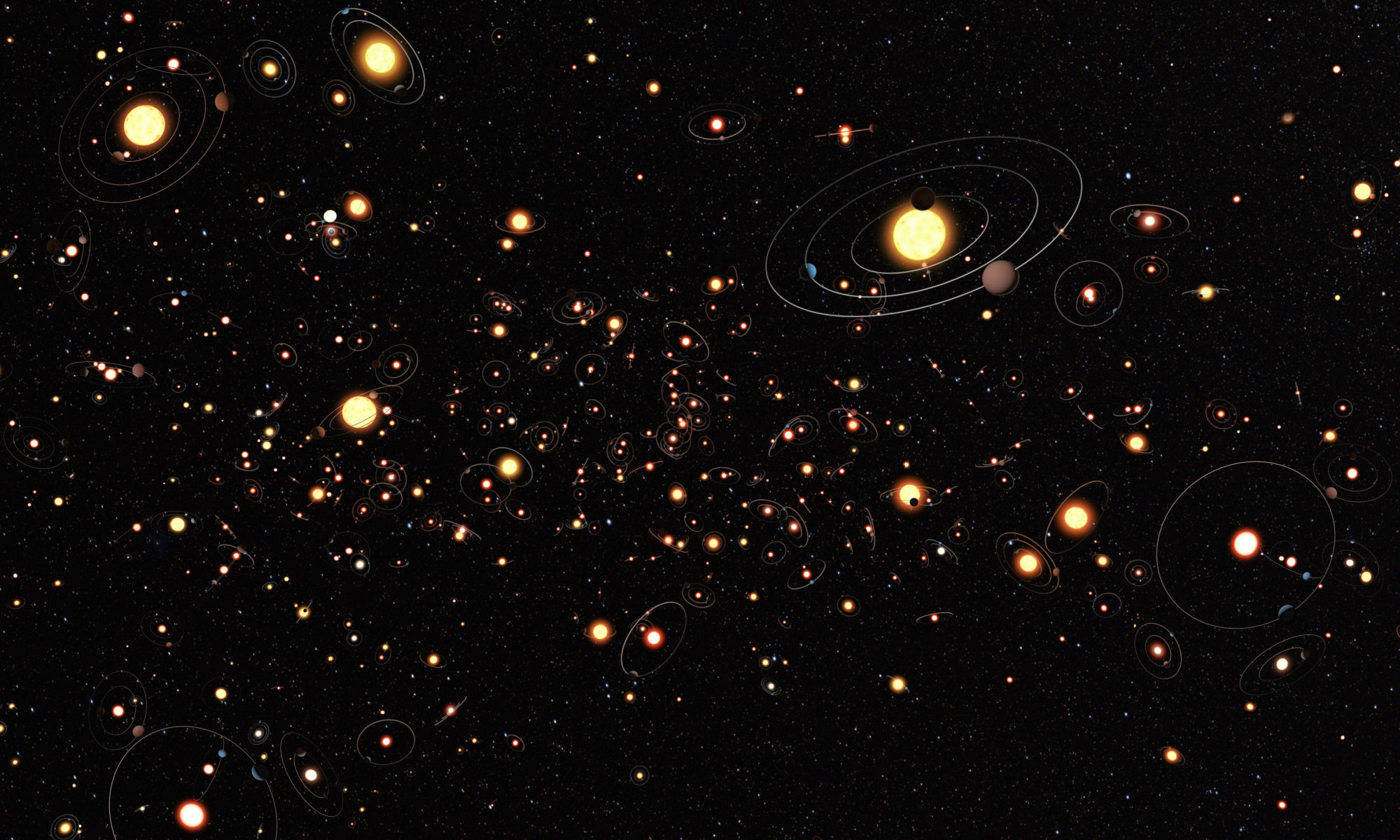Featured image: An artist’s depiction of many, many possible planets. This image was created by the European Southern Observatory (ESO).
Have you ever stayed up at night and wondered, why am I here? Or, more broadly, why are we here, including all living things on this Earth? Don’t worry, you’re not alone, and scientists like Professor Toby Tyrrell of the University of Southampton (UK) have been trying to answer these questions using the scientific method.
His conclusion? It may have just been the luck of the draw. After all, if we weren’t here in the first place, we couldn’t wonder why we were. (Scientists call this the weak anthropic principle.)
Climate scientists often describe their models as alternate (climate) histories. Tyrrell’s 2020 paper takes this idea to its ultimate conclusion, running 100 alternate climate histories on 100,000 randomly generated planets within the habitable zone of their randomly generated stars for 3 billion years. The question he’s trying to help answer is this: how likely was it that the Earth’s climate stayed habitable for the 4 billion years between the evolution of the first prokaryotic cells and us? Was it due to some intrinsic properties of planet Earth, or of life, or was it merely chance?
Tyrrell focuses on a specific aspect of that question: how likely is it that any habitable planet stays habitable long enough to generate complex life? He assumes that the 3 billion years it took to do so on Earth is a good representation of the length of the process in general. Mars and Venus may both have been habitable at some point in their histories, but clearly aren’t today (at least on a planetary scale). How many planets end up like that, and how many end up like Earth?
In order to run many simulations cheaply, he defines habitability as a planetary average temperature between about -10 and 80 degrees centigrade, which are conditions under which water can be liquid (even if it’s very salty) and life on Earth has been found. The author does acknowledge that more conditions are needed for life to exist, and that the average planetary temperature is only a rough approximation — much warmer or colder places suitable for life may exist even on an ‘uninhabitable’ planet by these guidelines. Still, it’s a good place to start, and allows him to simulate these hundred million planetary histories without breaking the computational bank.
Most (over 9 in 10, or 90,000 of all 100,000) of his simulated planets were never “successful” — they never stayed habitable for the entire 3 billion years, even across all of their 100 alternate histories (repeated simulations with slightly different chance events, such as a simulated asteroid strike at a certain time). But of those that were, they weren’t too likely to repeat the feat: around half of the successful planets were only habitable in 10% of their alternate climate histories, meaning that 90 of their 100 alternate histories ended up as an uninhabitable planet. Very few planets were self-stabilizing, meaning that they stayed habitable all of the time because whenever they started to get too hot or too cold, they came back from the brink and temperatures remained in the habitable range. That could have been due to chance alone, but Tyrrell ruled that out: chance alone would never have resulted in more than 10/100 successes at best for any planet, and some of his planets had a 100% or near-100% success rate. Instead, it was due to the presence of climate feedbacks like we have on the real Earth, that kick in to keep such planets from suffering a runaway greenhouse effect like Venus or freezing completely like Mars.
It’s worth noting that Earth itself may not have been habitable everywhere through its entire planetary history — the Snowball Earth period (or periods) likely involved a planetary temperature outside the bounds what Tyrrell defines as acceptable for his randomly generated planets, and the Hadean Era over 4 billion years ago, when the Earth was being bombarded by meteorites and comets, would have likely also not qualified. Some biologists believe that life evolved in hydrothermal vents in the deep oceans, where water temperatures can exceed boiling even if surface temperatures would be well below freezing. So Tyrrell’s definition of habitability declares Earth’s own history “unsuccessful”, because it’s based solely on the planet’s average simulated temperature. However, most of his “failed” planets get much, much more uninhabitable than Earth ever was during the course of their simulated eons.
Still, what Tyrrell presents is a comprehensive starting point for future investigation into random and chaotic processes in climate sensitivity and planetary habitability. In his conclusion he explicitly invites other researchers to compare alternate methodologies against his, and to share how (and if) the results differ. I hope other scientists take him up on this offer soon, because we have a lot to learn about planetary habitability and climate feedbacks.

